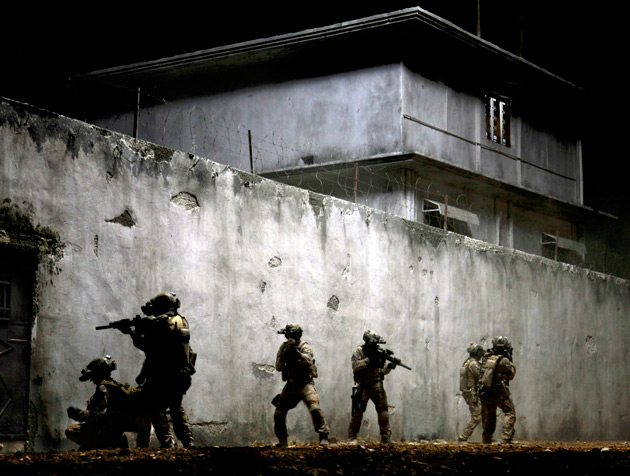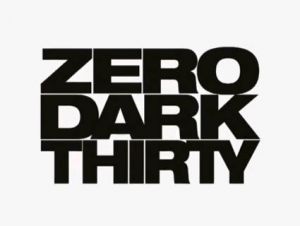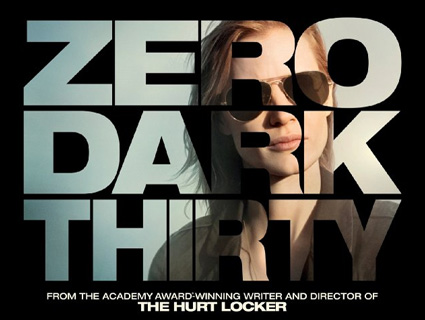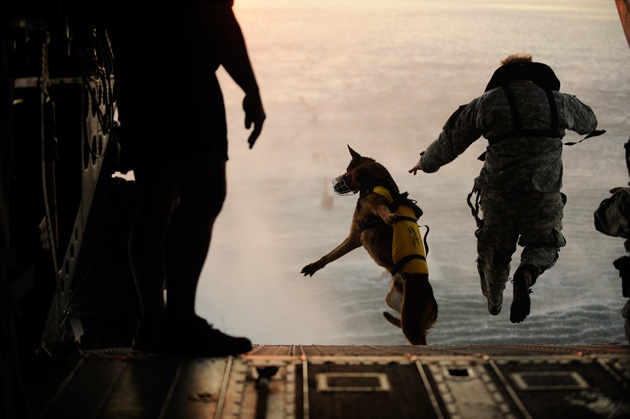
Navy SEALs outside Osama bin Laden's compound in Zero Dark ThirtyColumbia Pictures/Entertainment Pictures/ZUMAPRESS.com
Zero Dark Thirty is a gripping Hollywood epic, but the Oscar-nominated film has become best known for setting off a torrent of debate about whether torturing prisoners helped in the hunt for Osama bin Laden. Its opening sequence announces that the film is “based on firsthand accounts of actual events.” There is pretty clear evidence, however, that it gets the torture question seriously wrong, as more than one journalist has laid out in detail.
Then there is the matter of exactly how the Navy SEALs killed bin Laden. Ironically, a movie famously described by its director as a “journalistic account” gets little help on this front from practitioners of the trade. In the nearly two years since the mission, several respected journalists and even members of SEAL Team 6 itself have put forth different versions of how the killing went down. Since I first documented some of these divergent stories, more have piled up. The so-called fog of war is surely a factor; even America’s most highly trained warriors are bound to have faulty memories of such a heart-pounding, high-stakes mission. But from conflicting reports about real-time footage to various rundowns of the number of shooters, bullets fired, and witnesses present, the collection of accounts makes for a Rashomon-style epic of its own.
The basic facts are clear enough: On May 2, 2011, the SEALs stormed bin Laden’s compound in Abbottabad, Pakistan, shot him dead, and departed with his corpse by helicopter. The US military soon transported the body to a naval ship, where it was given Muslim burial rites and dumped into the ocean. Thus concluded an unambiguous and essential victory in the decade-old war on terrorism.
So why do the particular details of bin Laden’s death matter? For starters, questions still linger as to whether the Obama administration intended to capture or kill bin Laden. The White House maintained that taking him alive was a potential outcome of the raid, but as one special operations officer told journalist Nicholas Schmidle in The New Yorker, “There was never any question of detaining or capturing him…No one wanted detainees.” According to a report from the Associated Press, “to some in government and intelligence circles, the operation bore the hallmarks of a pure kill mission.” Some questioned whether bin Laden was killed illegally under international law, and in that regard the details of his demise potentially become crucial: Did the world’s most-wanted terrorist lunge for a gun in the moment of reckoning, or did he act “completely confused” and “cowardly” and offer no resistance? Did he shove his wife between himself and the SEALs, or did his wife throw herself into harm’s way to protect him?
The confusion flowing from official sources also points to the issue of government transparency—a balancing act with matters of national security, to be sure, and one where the White House has drawn no shortage of criticism. The news media, meanwhile, boasts a pretty lousy track record since 9/11 when it comes to vetting official claims about national security issues.
But judge for yourself: What follows are excerpts from six different accounts of bin Laden’s death. Together they reflect how murky the precise circumstances of his killing remain, particularly regarding key questions about whether the raid was filmed, who shot bin Laden, and which members of his family witnessed his death.
Account #1
Helmet cameras: Yes
OBL shot by: Multiple SEALs
Witnessed by: A wife and daughters
In May 2011, two weeks after the raid, CBS News national security correspondent David Martin reported that the entire 40-minute sequence at bin Laden’s compound was “recorded by tiny helmet cameras worn by each of the 25 SEALs.”
The SEALs first saw bin Laden when he came out on the third floor landing. They fired, but missed. He retreated to his bedroom, and the first SEAL through the door grabbed bin Laden’s daughters and pulled them aside. When the second SEAL entered, bin Laden’s wife rushed forward at him—or perhaps was pushed by bin Laden. The SEAL shoved her aside and shot bin Laden in the chest. A third seal shot him in the head.
Account #2
Helmet cameras: No
OBL shot by: One SEAL, with two shots
Witnessed by: Two wives
If only some real-time footage were available, it would be easy enough to clear things up. However: “The SEALs were not wearing helmet cams, contrary to a widely cited report by CBS,” Schmidle wrote in The New Yorker in August 2011. According to his description of the killing:
The Americans hurried toward the bedroom door. The first SEAL pushed it open. Two of bin Laden’s wives had placed themselves in front of him. Amal al-Fatah, bin Laden’s fifth wife, was screaming in Arabic. She motioned as if she were going to charge; the SEAL lowered his sights and shot her once, in the calf. Fearing that one or both women were wearing suicide jackets, he stepped forward, wrapped them in a bear hug, and drove them aside…
A second SEAL stepped into the room and trained the infrared laser of his M4 on bin Laden’s chest. The Al Qaeda chief, who was wearing a tan shalwar kameez and a prayer cap on his head, froze; he was unarmed…The first round, a 5.56-mm. bullet, struck bin Laden in the chest. As he fell backward, the SEAL fired a second round into his head, just above his left eye.
Account #3
OBL shot by: Unspecified
Witnessed by: One wife
In his May 2012 book Manhunt, Peter Bergen gave an account similar to Schmidle’s, but his only had one of the wives present and he didn’t specify who put the bullets into bin Laden:
Hearing the sounds of strange men rushing into their room, Amal screamed something in Arabic and threw herself in front of her husband. The first SEAL who charged into the room shoved her aside, concerned she might be wearing a suicide bomb vest. Amal was then shot in the calf by another of the SEALs and collapsed unconscious onto the simple double mattress she shared with bin Laden. Bin Laden was offering no resistance when he was dispatched with a “double tap” of shots to the chest and his left eye. It was a grisly scene: his brains spattered on the ceiling above him and poured out of his eye socket. The floor near the bed was smeared with bin Laden’s blood.
Account #4
OBL shot by: Three SEALs, with two shots outside the bedroom, then multiple shots inside the bedroom
Witnessed by: Two women
According to the September 2012 book No Easy Day by “Mark Owen”—later identified as SEAL Team 6 member Matt Bissonnette—three different SEALs shot bin Laden, who was already in his death throes when they entered the bedroom and pumped additional rounds into his body:
We were less than five steps from getting to the top when I heard suppressed shots. BOP. BOP. The point man had seen a man peeking out of the door on the right side of the hallway about ten feet in front of him. I couldn’t tell from my position if the rounds hit the target or not. The man disappeared into the dark room.…
We didn’t rush. Instead, we waited at the threshold and peered inside. We could see two women standing over a man lying at the foot of a bed…The women were hysterically crying and wailing in Arabic. The younger one looked up and saw us at the door. She yelled out in Arabic and rushed the point man. We were less than five feet apart. Swinging his gun to the side, the point man grabbed both women and drove them toward the corner of the room…
With the women out of the way, I entered the room with a third SEAL. We saw the man lying on the floor at the foot of his bed. He was wearing a white sleeveless T-shirt, loose tan pants, and a tan tunic. The point man’s shots had entered the right side of his head. Blood and brains spilled out of the side of his skull. In his death throes, he was still twitching and convulsing. Another assaulter and I trained our lasers on his chest and fired several rounds. The bullets tore into him, slamming his body into the floor until he was motionless.
Account #5
OBL shot by: One SEAL, with one shot each in the chest and left eye
Witnessed by: One wife
With the first edition of his book, The Finish, published in October 2012, journalist Mark Bowden was compelled to include an insert explaining discrepancies between his account and Bissonnette’s, which had been published the prior month. “I assume [his] account is accurate though the account here was reviewed at the highest level of Special Forces Command and confirmed as accurate before the book went to press,” Bowden wrote. From his book:
Three SEALs came up those stairs, scanning different angles, searching while protecting each other. The first man up spotted a tall, bearded, swarthy man in a prayer cap wearing traditional flowing Pakistani clothes, the knee-length skirt worn over pajama-like bottoms. The man retreated quickly and the SEAL followed, with the other two close behind. As the first entered the bedroom he saw bin Laden, but first had to contend with Amal, who shouted and moved in front of her husband. The SEAL knocked her aside as his teammate shot bin Laden in the chest. The Sheik fell over backward, faceup. The SEAL who had shot bin Laden was over him instantly and shot him once more through the left eye.
Account #6
OBL shot by: One SEAL, with three shots to the forehead
Journalist Phil Bronstein’s much-discussed story, recently published by Esquire and the Center for Investigative Reporting, relied on a series of interviews with a source identified only as “the Shooter.” It was billed as “the most definitive account of those crucial few seconds when bin Laden was killed.” Bronstein noted: “Not in dispute is the fact that others have claimed that they shot bin Laden when he was already dead, and a number of team members apparently did just that.” The story offered yet another version of the kill shots, in the Shooter’s own words:
I’m just looking at him from right here [he moves his hand out from his face about ten inches]. He’s got a gun on a shelf right there, the short AK he’s famous for. And he’s moving forward. I don’t know if she’s got a vest and she’s being pushed to martyr them both. He’s got a gun within reach. He’s a threat. I need to get a head shot so he won’t have a chance to clack himself off [blow himself up].
In that second, I shot him, two times in the forehead. Bap! Bap! The second time as he’s going down. He crumpled onto the floor in front of his bed and I hit him again, Bap! same place. That time I used my EOTech red-dot holo sight. He was dead. Not moving. His tongue was out. I watched him take his last breaths, just a reflex breath…
His forehead was gruesome. It was split open in the shape of a V. I could see his brains spilling out over his face. The American public doesn’t want to know what that looks like.
Unsurprisingly, Zero Dark Thirty uses its own amalgamation of similar details for bin Laden’s final moments, and then some. (Look for the SEAL trying to soothe a child terrified by the carnage with a glow stick.) But the filmmakers apparently agreed with the Shooter’s sentiment: They never give viewers a direct look at bin Laden’s dead visage. (The Obama White House also refused to provide one to the public.) As the credits rolled at the screening I attended in San Francisco, an audience member behind me commented, “I wonder how much of it was true.” With a laugh, his friend replied: “Well, they say the whole thing is.”















